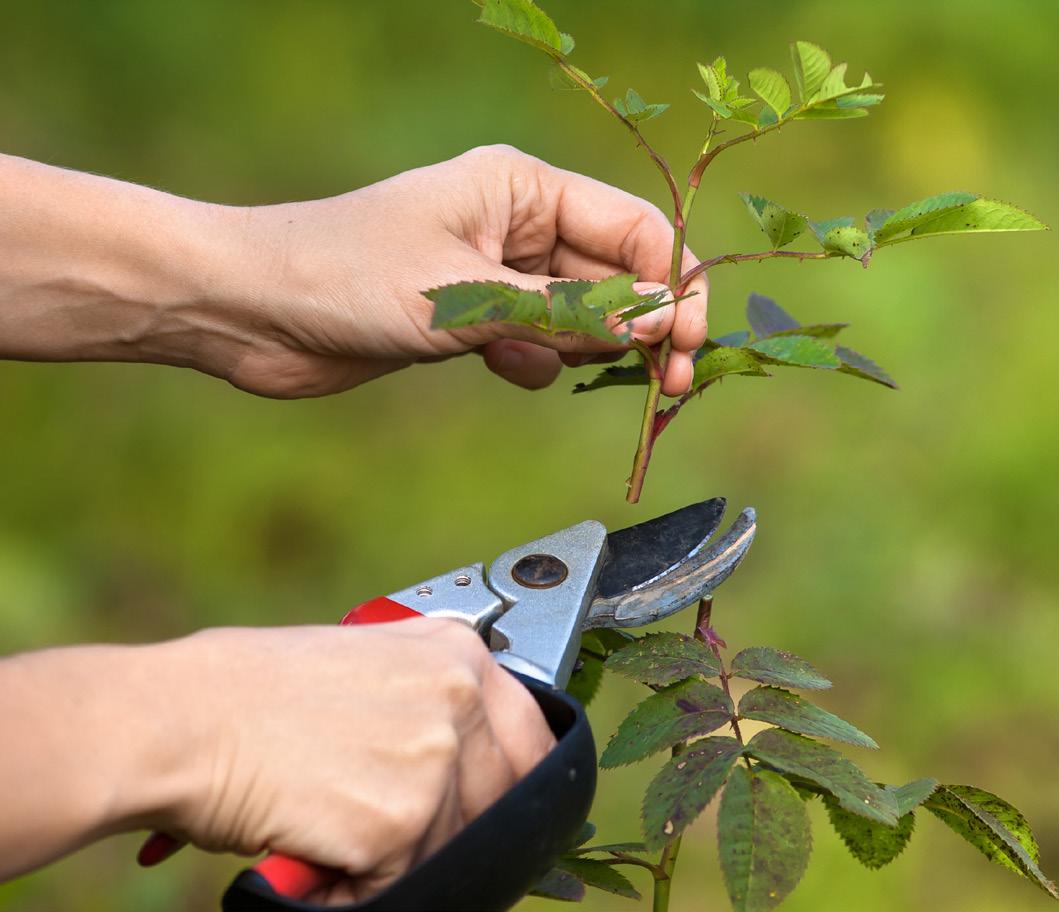
4 minute read
Joanna Radford: Roses are
Roses are Red… and More
“Roses are red. Violets are blue. Sugar is sweet and so are you!”
Advertisement
This sweet saying may send your thoughts back to a time when you first heard it. Maybe it was a time when you wrote to your high school sweetheart or maybe it was when one of your parents or grandparents said this to you. Whatever the situation, the poem likely brings with it a warm feeling of love.
Red roses are known as the flower of love. Many are gifted throughout the year, and even more popularly given during the month of February. Some of these are in the form of cut roses, some are rose petals, and some are rose bushes. The rose bush may be planted and enjoyed for years to come. For successful roses, it is important to care for them throughout the years.
Roses require pruning to thrive which encourages new growth and flowers, increases sunlight into the plant, improves air circulation, and directs new growth which results in a beautifully shaped plant. Pruning gives roses a non-productive, resting time that helps prolong the life of the bush. It is best to prune each year as it also encourages maximum flower quality and quantity for the home garden.
The best time to prune will depend on the type of rose bush. Old-fashioned roses and climbers that bloom only one time a year should be pruned immediately after flowering. They bloom on wood from the previous year’s growth. Do not prune these rose bushes heavily in the spring for the buds may be pruned off making them unable to produce flowers or have fewer flowers. Tea roses are pruned for their shape and usually require severe pruning cuts. Knockout roses can be lightly pruned to control the size of the shrub in late February and can be heavily pruned every few years when needed to control the size. To determine when to prune, look at the buds. Prune when the buds begin to swell. A good rule of thumb, watch for the forsythia to bloom. That is when it is time to prune! Prune with sharp pruning shears. Make clean cuts at a 45-degree angle, approximately ¼ inch above a healthy bud that is facing toward the outside of the plant. This cut directs the new growth outward. Remove all weak or twiggy growth on main canes that are thinner than a pencil. Cut away any crossing branches. Lastly, remove suckers, if present. Suckers are new growth from the root structure below the graft or bud union. Sanitize pruning shears in a 70 percent alcohol solution frequently to decrease the spread of disease. Gloves may be needed to protect hands and forearms from thorns.
Pruning is work but the reward is worth it. The flowers can be enjoyed in the landscape or cut and enjoyed inside. Take special care not to damage rose canes when removing the flowers. For first year roses, allow them to bloom and do not prune. After the rose bush has matured the flowers can be pruned yearly.
If looking for the perfect rose, research the hardiness (7A) for our area in rose catalogs and pay attention to the descriptions and ratings of the “All America” winners. These have been “tested nationally and proven locally” for superior garden performance by horticulture professionals across North America. The most common classifications of roses are hybrid tea, floribunda, grandiflora, climber, miniature, and shrub roses. They bloom repeatedly throughout the growing season. Most of the other species only bloom once, in June or July.
Hybrid Teas are the most popular garden roses and are hardy in North Carolina. They have a bush form with large flowers, borne singly or in small clusters on a stem. Blooms can be seen throughout the summer and fall until frost.
Floribunda roses have smaller flowers than hybrid teas but produce more flowers on each stem. They are low-growing, densely branched bushes adaptable to many landscape uses. Colors range from snowy white to deep crimson.
Grandiflora roses are a cross of hybrid tea and floribunda roses. They are vigorous and produce larger, but fewer flowers than the floribunda.
Climbing roses sends out long shoots or canes which can be trained over fences, arbors, or trellises. Characteristics of
climbing roses vary greatly. Some bloom only once, others bloom continuously. Some have large, hybrid tea type blooms, others bloom in small clusters.
Miniature roses are hardy in North Carolina and small in stature. They range from 3-12 inches in height and have small buds, stems, foliage, and flowers. They are available in many colors and can grow as outdoor landscape plants and indoor potted plants.
Shrub roses are bushy and have a shrub-like form. They are vigorous, hardy, and are adapted to a wide landscape use.
The American Rose Society is a great resource to help you select the perfect rose bush. Their website is www.rose.org/. And with Valentine’s Day this month, roses would be the perfect gift to show your special someone your love.





Mt. Airy’s Premier Retirement Community 1000 Ridgecrest Lane • Mt. Airy, NC 27030 (336) 443.6953 • Ridge-Crest.com








